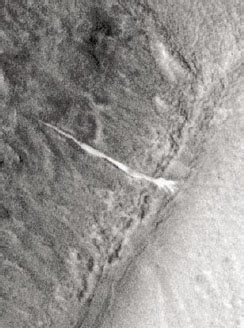|
Vol. 228 No. 1 |

|
 |
| PERRY A. FISCHER, EDITOR |
Mars flows liquids. You may have recently heard of the evidence of flowing water on Mars. However, many of the popular news media botched the report and forgot to include that the water was flowing recently—within the last seven years! Or the fact that there are two different discoveries of recently flowing water.
In a belt around the planet at southern mid-latitudes, evidence of flowing water, i.e., gullies and washouts, has been seen before, but their age was unknown. During the course of the Mars Global Surveyor mission, images from the Mars Orbiter Camera showed that the walls of two unnamed craters in the Terra Sirenum and the Centauri Montes regions have new, light-toned deposits that formed in gully settings. The photographic evidence shows that one of the gullies must have formed between August 30, 1999, and February 21, 2004.
The new deposits exhibit characteristics consistent with transport and deposition of a fluid that behaved like liquid water and likely transported some fine-grained sediment along with it. The distal end of the flow broke into several branches when it hit the crater floor, and the material diverted and flowed around low obstacles. In both cases, the flow thickness was too thin to be resolved in 1.5-m/pixel images, so a small volume of liquid and sediment was involved. While the material flowed and easily budded into several branches, it also must have moved slowly, because it did not flow over-top some of the low obstacles in its path.
The new gully deposits do not occur in regions where slope streaks occur, nor are they found near any dark slope streaks. They clearly appear to be bursting out from crater walls. The most likely hypothesis is that the water flows from melted, subsurface ice. So, the search is now for further conformation of subsurface water that could be detected by orbiting, ground-penetrating radar systems such as the Mars Express or Mars Shallow Subsurface Radar.
Numerous photos of flows of apparently dry material, probably dust, exist; but these appear as dark streaks and are different in character and location. Scientists were careful to note that it is possible that the new flows are not water. Such a disclaimer is in keeping with good science, and the fact that liquid water on Mars would be a spectacular discovery. Water means the potential for life and makes human colonization more possible, since oxygen and hydrogen could be derived from it. But realistically, everything points to liquid water as the culprit.
Cambrian explosion, Part 2. This follows on the heels of my November piece on the Cambrian Explosion. After three billion years of mostly single-celled evolution, complex, multi-celled life forms suddenly appear in the fossil record—the Cambrian Explosion. It has long been hypothesized (J. R. Nursall, 1959) that oxygen levels could be the reason for the Explosion, but there's been no hard evidence for this.
 |
New gully deposit in Martian crater Terra Sirenum. Courtesy NASA/JPL/Malin Space Science Systems.
|
|
�The presence of oxygen on Earth is the best indicator of life,� says John Grotzinger, a geology professor and an authority on sedimentary geology at California Institute of Technology. �But it wasn�t always that way. The history of oxygen begins about two and a half billion years ago and occurs in a series of steps.� He coauthored a paper where the subject is the last step-wise increase in global oxygen levels. It appeared in the Dec. 7 issue of Nature.
In the oil fields of Oman, geologists found that there was a sudden change in the oxygenation of the world�s oceans at the time just before the Cambrian Explosion. Dave Fike is lead author of the paper and one of Grotzinger�s students. He made the key discovery by analyzing core samples and drill cuttings taken at about 10,000 ft from Omanian oil wells, which are believed to have the world�s oldest commercially viable oil. By analyzing carbon and sulfur isotopes in the rock, the team was able to determine that the world�s oceans contained much less oxygen 550 million years ago, before the Cambrian, and were anoxic at depth, more similar to the Black Sea today.
Remarkably, a separate paper by a different team, working on the same subject, appeared in the online version of Science on the same day. Even more noteworthy, the team used different methods, but came to the same conclusion.
In 2002, Guy Narbonne of Queen�s University in Kingston, Canada, and his research team found the world�s oldest complex life forms�more than 575 million years ago�at Mistaken Point on the coast of Newfoundland.
Until 580 million years ago, glaciers covered much of the planet with thick ice sheets. Exactly how much is not known. There were at least three great glaciation periods in Precambrian times. In Newfoundland, there is evidence that upon the melting of the last one, the Gaskiers glaciation, nutrients were perhaps added to the world�s oceans, leading to a proliferation of photosynthetic single-celled organisms and changing oxygen levels dramatically. The Science paper showed that through geochemical analysis, especially of iron, the ocean bottom was nearly devoid of oxygen 600 million years ago; then a rapid rise in oxygen occurred, to at least 15% of today�s level. The flat, soft-bodied Ediacara-period fauna spread across the seafloor within five million years after oxygen permeated the oceans.
The two studies agree with each other, but there are still issues in precise resolution of the time line that need to be worked out. This is the first solid evidence that an abrupt increase in the availability of oxygen led to the diversity and complexity of life as we know it today. <img width="24" height="12" align="ABSMIDDLE" alt="WO" src=%2
|





